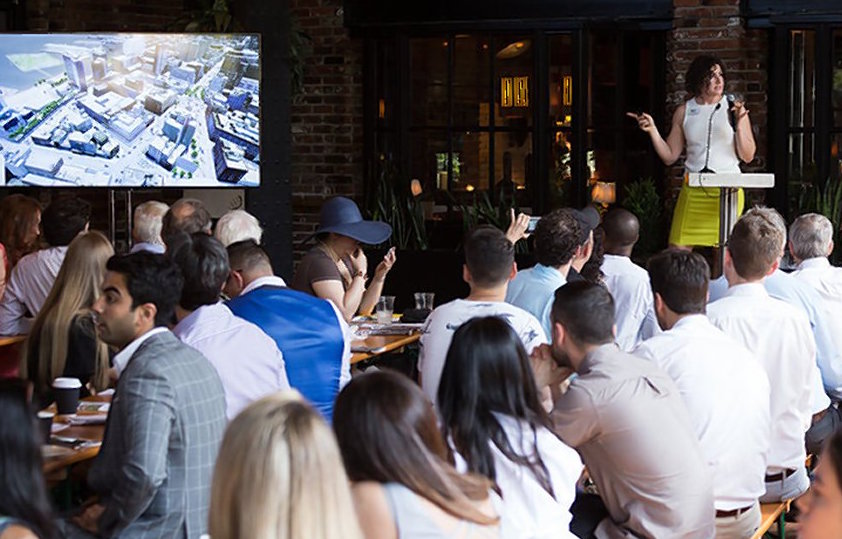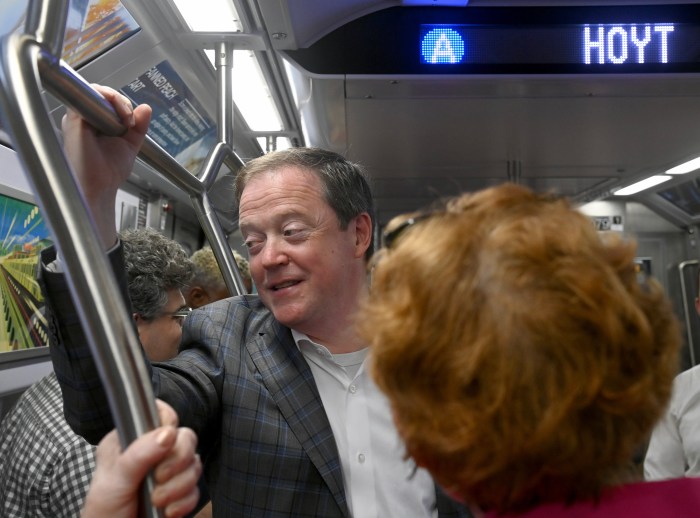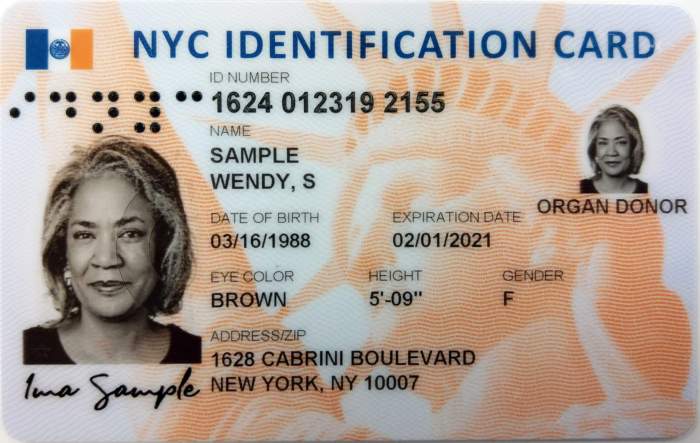
BY MICHELE HERMAN | I recently went to the annual meeting of the Meatpacking Business Improvement District. I’ve always had an uneasy feeling about the extra-governmental taxing entities known as BIDs and I figured I should learn more about this one, formed in 2014 so close to my West Village home.
I also went in solidarity with friends who live on the edge of the district and have been losing sleep for years from late-night restaurant, club and private-party noise. And I have to admit that I went because it was being held at The Standard Hotel’s Biergarten (speaking of noisy restaurants) and they were serving breakfast.
I learned that it’s been a tough year, and maybe a transformational one, in the Meatpacking District. The area is filled with both vacancies and construction sites, including the glass office tower on W. 15th St. that will house the giant Starbucks Roastery, the “Solar Carve” on 10th Ave.
Meanwhile, as part of its regular work, the Department of Transportation has torn up the area’s streets and plazas to replace pipes and sewers. This has been tough on businesses; I talked to a woman from Fig and Olive on W. 15th St., who said the restaurant suffered enormously from daytime water shutoffs and from the block-long chain-link fence that’s set smack against the sidewalk.
Residents in and near the district report a silver lining, though: The late-night crowds and noise have diminished considerably. No one is quite sure what to expect when the streets and plazas are put back together.
As I read the annual report booklet and watched the presentation, complete with nifty 3D simulation of the neighborhood in the near future, my radar was tuned for both hope and alarm. On the hopeful side, the streets will now be freshly cobbled, with proper crosswalks, bike lanes and plantings. The BID’s executive director, Lauren Danziger, seems like a dynamo. And the BID is trying very hard to market the area as a culture, high-tech and fashion district, not a late-night clubbing one.
On the alarming side, I’m a Villager, and it’s deep in my DNA to distrust a board that looks like a roll call of big developers: Taconic, Aurora, Related, Romanoff, Jamestown. Sure they’ve helped create niceties, like plazas and extra weekend security, but they’re also the ones who chip away at the historic fabric, quirkiness and affordability of the low-rise district in the first place.
I couldn’t help rolling my eyes when one of the BID’s founders, who’s stepping down from the board, came to the podium to talk about the organization’s history. He made it sound as if he and his cohort from the two precursor organizations (the Meatpacking Improvement Association and the Chelsea Improvement Company) were a small band of grassroots activists with so little cash that they needed to ask the other local businesses to chip in for services. I rolled my eyes because this was Paul Pariser talking, chairperson of Taconic Investment Partners.
Pariser also talked about what an amazing asset the “Meatpacking” name is, what with cities around the world all claiming their own little spinoffs. As someone who knows the area by its working name (the Meat Market), I cringed, the way Hell’s Kitchen residents must when they hear their neighborhood called Clinton (its real-estate name).
Three additional notes of alarm: Danziger sometimes lapsed into PR-speak like this: “…offering visitors an interactive and layered shopping experience.” As I wondered whether I’ve ever had a layered shopping experience, two images that popped up on the 3D simulation stopped me cold: the two tall new buildings proposed for the southeast corner of Gansevoort and Washington Sts. to replace the low-rise ones there now, as part of the “Gansevoort Row” project, and “Diller Island,” a.k.a. Pier55, the proposed park/performing arts center in the Hudson River. Neither of these is a done deal, and both are mired in controversy.
Finally, I was concerned about the discrepancy between the grand talk about the district’s uniqueness and the reality of the roster of tenants moving in: Restoration Hardware, Starbucks, Hermes.
Elaine Young, a longtime local activist and one of two members of the BID’s IAAC (Impact Area Advisory Committee, something she pushed to create so that residents just beyond the BID’s borders could have a seat at the table), shared my alarm.
“I think it’s very interesting that they did that,” Young said, referring to the image of the redeveloped Gansevoort St. “We’re not there yet. We’re in a lawsuit. That upsets me. That’s the kind of attitude we have to deal with.”
After talking to various other players and learning more about the organization, I still feel that BID’s are dubious creatures. They force a tax on everyone within their borders. They are supposed to remain neutral politically but have boards filled with individuals representing companies with a vested interest in development. And BID’s quite likely accelerate the cycle of ever-increasing rents that tends to force out longtime residents and small independent business owners.
That’s not the whole story, though. Maybe we’re all just tired and demoralized watching the rancor of our national politics. But the more people I talked to, the more hopeful I felt that this BID is well aware of the potential pitfalls and is doing far more good than harm.
For one thing, the BID is helping people who are trained to be wary of each other get out of their small bubbles to find common ground. As Donna Raftery, a longtime Gansevoort St. resident and one of the BID’s two resident members, put it: “There are a lot of things we all have in common: Everyone wants the streets to be clean and safe, and no one wants someone peeing on their doorstep.”
Raftery said that the BID has made her more sympathetic to business owners, who face their own set of challenges.
“I would be thrilled,” she added, “if anyone on the business end said the same about us residents.”
Yet she noted that she has no illusions about the BID.
“There are seven or eight businesses to every one resident represented,” Raftery said. “It’s inherently about the businesses.”
But she feels that the BID provides a forum for people to hear each other out, plus a powerful voice when larger issues arise and valuable relationships with the movers and shakers in each area business. Raftery has had a good working relationship with the BID’s community affairs staffer, Jeffrey LeFrancois.
“We used to go to the Sixth Precinct” when we had issues, Raftery said. “The BID will have more pull with the Sixth Precinct, because they represent tax dollars. I think that’s a benefit.
“Here’s what I wish the members would take from this,” she added. “The people who live here are not necessarily the enemy. The things the people want are good for the neighborhood as a whole. I don’t think the people on the BID like the 4 a.m. club scene: it’s just a bunch of problems.”
When I talked to Danziger, she spoke proudly of the way the BID changed the conversation this year, in part through its two-month pop-up ARTtech interactive exhibit/workshop in one of the vacant spaces.
“The press was covering the Meatpacking District as a place to go and drink,” she said, “an empty and non-meaningful neighborhood full of vacancies. We used the vacancy to help tell a story of culture and art and technology.”
I asked her about all the things I found alarming at the annual meeting, and she was ready with answers, some of which convinced me more than others. She said that the presentation included the redeveloped Gansevoort St. and Diller Island because the BID has to plan for the likely future. Her marketing-speak? As someone who worked in finance, was a global meeting planner and a Chamber of Commerce employee, she’s used to talking to businesspeople, and this is the language they speak. But now she has a wider constituency that includes local residents and local politicians.
“I’m trying to make the conversation resonate for everyone,” she said.
Finally, on the question of big chains moving in, she said they must respect what’s here already.
“My hope is that these businesses acknowledge that they chose the neighborhood for specific reasons and honor it,” she said. “What makes the neighborhood so special is how the community comes together, and we will continue to foster that sense of community. At the core, everyone’s value is the same. I’ve been here a long time. People come with a smile or with vitriol they’ll spill. They come away realizing we all want the same thing.”
Hermes strikes me as a particularly ironic addition: the uber-patrician company known for its horsey-set accessories moving in to the neighborhood known for hanging beef carcasses.
“I think they’re recognizing that they need to develop a new consumer base,” Danziger offered. “The Meat Market attracts a creative, dynamic patron. Where better to do that?”
She shut me up with one good example of a company that has put its money where its mouth is. I mentioned a complaint I’d heard from a Chelsea resident about deafening noise from fans in the behemoth Google building. Danziger hadn’t heard about this, and seemed both concerned and extremely eager to help. What’s more, she said, Google has gone out of its way to add value to the neighborhood.
“Google helped us underwrite the free WiFi in the plazas,” she said. “It was not a small endeavor and they get no credit. They are hyperaware that they can be seen as insular.”
She told me that the company approached the BID and together they created a Neighborhood Night Out program in which local businesses sign up to host an event or tour to get Google employees into the neighborhood. The only rule is that the event can’t be profit-oriented. Last year, there were 18 tours, three times a night, and 2,400 Google employees took part.
I’m not sure what a creative, dynamic patron is exactly, but I like the BID’s fierceness.
“We don’t let anyone get away with anything,” Danziger said.

















